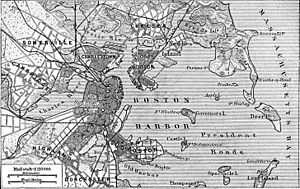Apple Island (Massachusetts) facts for kids
Apple Island was once a small island in Boston Harbor, Massachusetts. Over many years, it became part of the mainland. This happened when people used landfill to connect several islands. Apple Island and four other islands helped create East Boston and Logan International Airport. The other islands were Noddle's Island, Hog Island, Bird's Island, and Governor's Island.
Island History
In its early days, Apple Island was known for its elm trees. It was about 10 acres in size. However, it was hard to reach because of wide, flat areas of land that appeared at low tide.
The island first belonged to the town of Boston. People used it for grazing sheep and cattle. In 1723, it became private property. Thomas Hutchinson, whose son later became a Royal Governor, owned it.
Later, in 1802, the elder Hutchinson left the island to an English sailor. Then, in 1822, a man named Mr. Marsh bought the island for $550. Mr. Marsh passed away in 1833 and was buried on the island. His house on the island burned down two years later.
Apple Island was left empty for several years. In 1867, the City of Boston bought it back. They then sold it to other private citizens. People living on the island were known for pulling wrecked steamships onto the shore. They would then burn the ships to get copper and iron parts. Some of these ships included the James Adger, the Baltic, and the Ontario.
Becoming Part of the Airport
In the 1940s, Apple Island was used to expand Boston Airport. This project involved adding about 1,800 acres of new land. This new land was created using land reclamation in Boston Harbor. Material for this came from Apple Island, Governor's Island, and Noddle's Island.
In 1943, the state officially renamed the airport. It became General Edward Lawrence Logan International Airport. This was done to honor Edward Lawrence Logan, an officer from the Spanish–American War.


